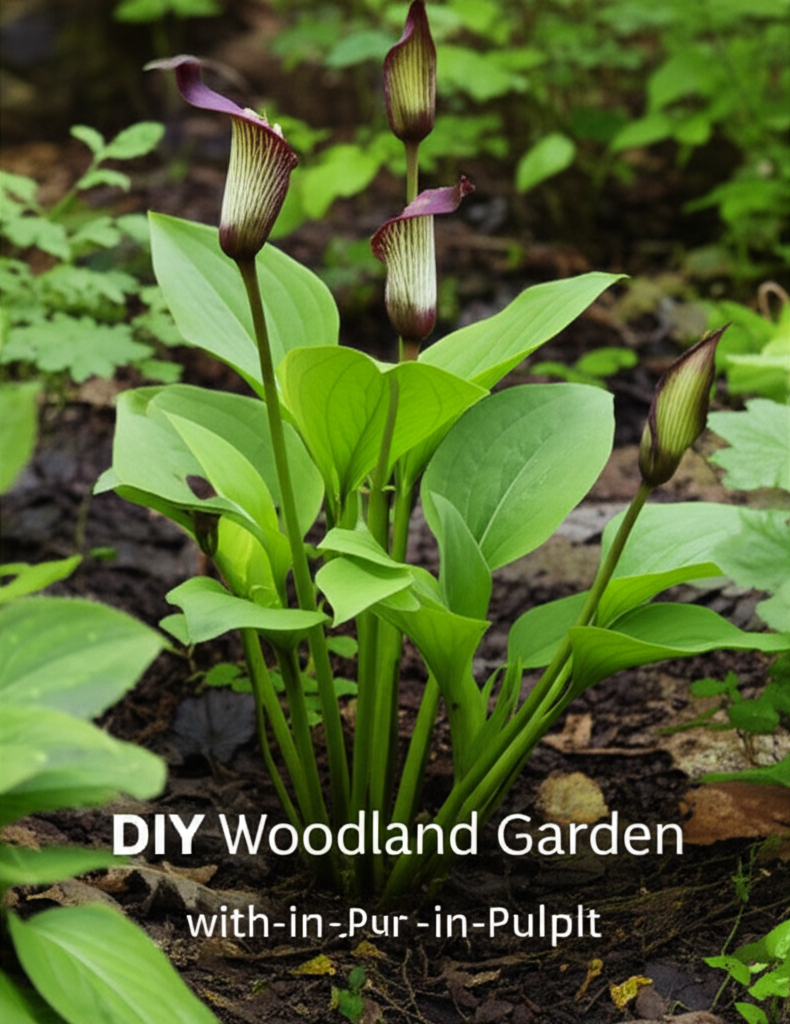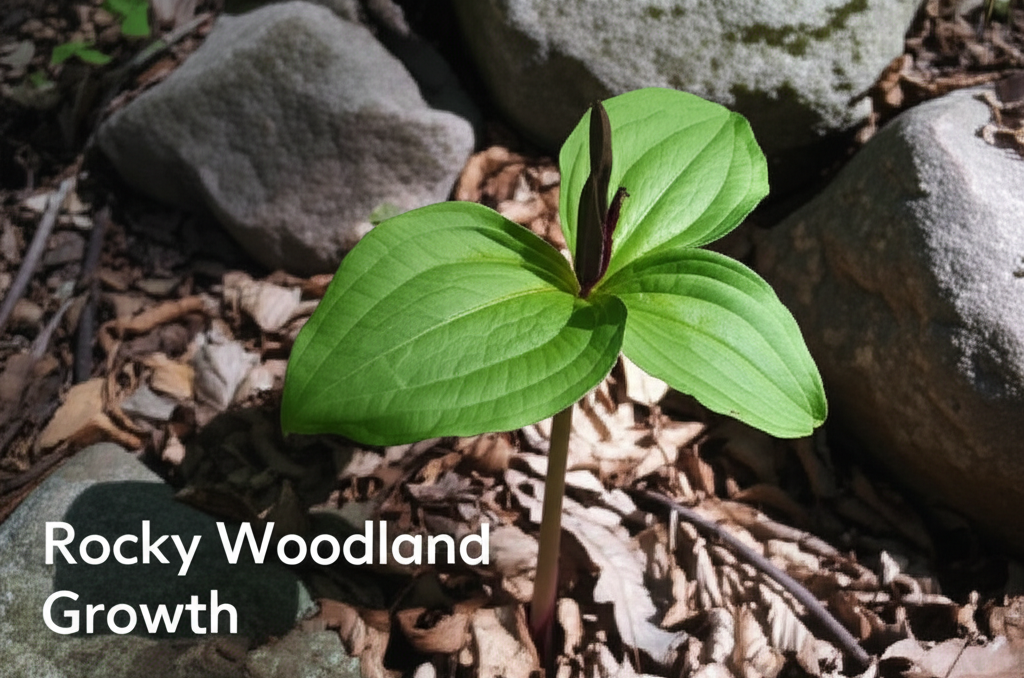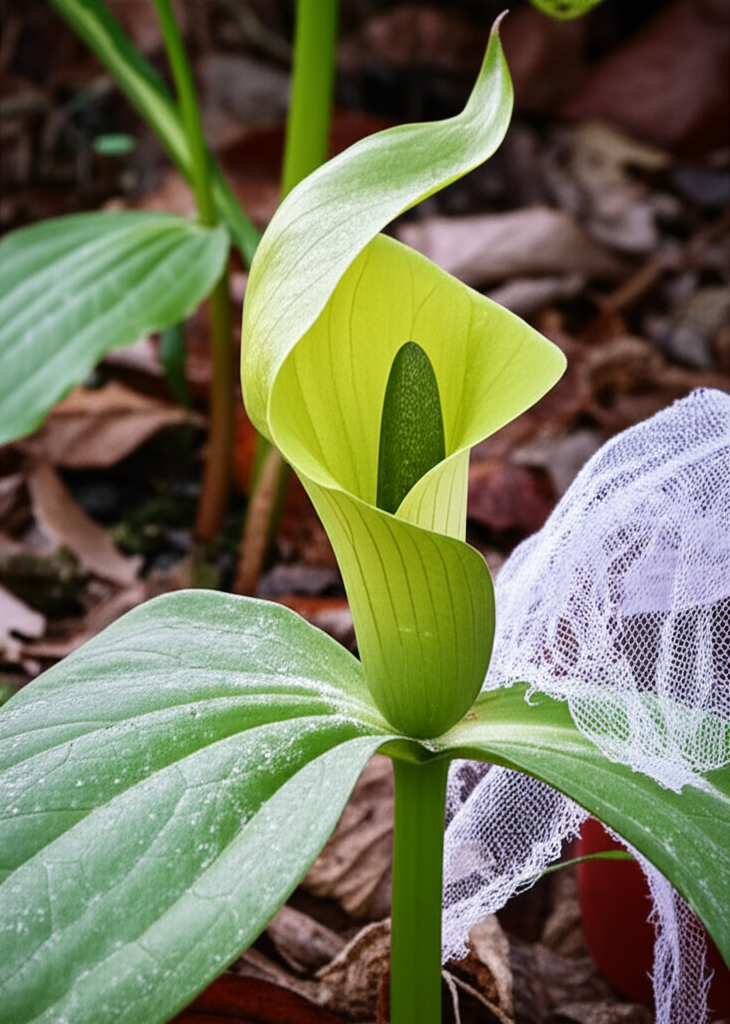Embrace the Magic of the Woodland Floor: A DIY Jack-in-the-Pulpit Garden
The allure of the woodland is undeniable. Dappled sunlight filtering through a canopy of leaves, the earthy scent of damp soil, and the whisper of wind through ancient trees evoke a sense of peace and wonder. For many, recreating this natural sanctuary in their own backyard is a cherished dream. And what better way to capture this essence than by cultivating a garden centered around the captivating Jack-in-the-Pulpit (Arisaema triphyllum)? This remarkable native wildflower, with its unique hooded spathe and striking berry-laden stalk, is the quintessential star of any shaded woodland retreat.
This comprehensive guide will walk you through every step of creating your own DIY woodland garden, focusing on the successful cultivation of Jack-in-the-Pulpit. We’ll delve into understanding its needs, selecting the perfect location, preparing the soil, choosing companion plants, and providing ongoing care. Prepare to transform a neglected shady corner into an enchanting, low-maintenance haven that echoes the timeless beauty of nature.
Understanding Jack-in-the-Pulpit: Nature’s Tiny Cathedral
Before embarking on your gardening journey, it’s crucial to understand the plant you’re working with. Jack-in-the-Pulpit, also known as Indian Turnip or Bog Onion, is a perennial herbaceous plant native to eastern North America. Its common name derives from its distinctive inflorescence: a hooded spathe that curves over a central spadix, resembling a preacher in a pulpit.
The plant typically emerges in early spring, often before the full canopy of the forest has developed. It thrives in moist, humus-rich soils and partial to full shade. Its life cycle is fascinating: it starts as a single-leaved seedling and, as it matures over several years, develops into a two- or three-leaved plant capable of flowering. After flowering, it produces a cluster of vibrant red berries in late summer or fall, adding another layer of visual interest.
Key Facts about Jack-in-the-Pulpit
| Feature | Description |
| :————— | :——————————————————– |
| Scientific Name | Arisaema triphyllum |
| Common Names | Jack-in-the-Pulpit, Indian Turnip, Bog Onion, Devil’s Ear |
| Native Range | Eastern North America |
| Light Needs | Partial to full shade |
| Soil Preference | Moist, well-drained, rich in organic matter (humus) |
| Bloom Time | Spring (April-June) |
| Height | 1-3 feet |
| Flower Type | Unique hooded spathe and spadix |
| Fruit | Bright red berries in late summer/fall |
| Dormancy | Herbaceous perennial; dies back in winter |
| Toxicity | Contains calcium oxalate crystals; toxic if ingested raw |
Designing Your Woodland Oasis: Location, Location, Location!
The success of your Jack-in-the-Pulpit garden hinges on selecting the right spot. These plants are woodland dwellers at heart, meaning they crave shade and moisture.
Choosing the Ideal Location
- Shade is Paramount: Look for areas that receive dappled sunlight or full shade for most of the day. The north or east side of your house, beneath deciduous trees, or in areas naturally shaded by existing structures are excellent candidates. Avoid south- or west-facing locations that receive intense afternoon sun, as this can scorch the leaves.
- Moisture Retention: Jack-in-the-Pulpit enjoys consistently moist soil, but it must also be well-drained to prevent root rot. Areas that tend to hold moisture after rain but don’t become waterlogged are ideal. Avoid low-lying spots where water pools.
- Soil Conditions: The existing soil should ideally be rich in organic matter. If your soil is heavy clay or sandy, you’ll need to amend it significantly.
- Protection from Wind: Strong winds can damage the delicate foliage of woodland plants. A location protected by shrubs, fences, or larger trees is beneficial.
Assessing Existing Conditions
Take time to observe your chosen area throughout the day and across different seasons. Note how the light changes and how the soil behaves. This initial assessment will inform your preparation steps.
Preparing the Soil: Building a Fertile Foundation
Woodland plants, including Jack-in-the-Pulpit, thrive in soil that mimics their natural habitat – rich, moist, and teeming with life. Soil preparation is arguably the most critical step in establishing a successful woodland garden.
Amending the Soil
The goal is to create a loose, well-draining soil structure that retains moisture and provides essential nutrients.
- Incorporate Organic Matter: This is the cornerstone of woodland gardening. Generously mix in compost, well-rotted leaf mold, or aged manure. Aim for a soil mixture that is at least 25-30% organic matter.
- Improve Drainage: If your soil is heavy clay, add coarse sand or perlite to improve drainage. If it’s very sandy, more compost will help it retain moisture.
- Adjust pH: Jack-in-the-Pulpit prefers slightly acidic to neutral soil (pH 5.5-7.0). Most amendments, like compost, will naturally move the pH in this direction. You can test your soil pH with a simple kit if you are concerned.
Tilling and Loosening
Once amendments are added, gently till or loosen the soil to a depth of at least 8-12 inches. This aerates the soil and makes it easier for the roots to establish. Avoid over-tilling, which can destroy soil structure and harm beneficial microorganisms.
Planting Your Jack-in-the-Pulpit: A Step-by-Step Approach
With your location chosen and soil prepared, it’s time to introduce your star performer. Jack-in-the-Pulpit is typically planted from corms (which look like bulbs).
When to Plant
The best time to plant Jack-in-the-Pulpit corms is in the fall, after the plant has gone dormant and before the ground freezes. This allows the corms to establish their root system over winter and be ready to grow in spring. You can also plant them in early spring as soon as the ground can be worked.
Planting Process
- Prepare the Corms: Inspect the corms for any signs of damage or rot. If they feel dry, you can soak them in lukewarm water for a few hours before planting.
- Dig the Hole: Dig a hole that is about 4-6 inches deep. The depth depends on the size of the corm; generally, plant it about twice its depth.
- Spacing: Space Jack-in-the-Pulpit plants about 6-12 inches apart. This allows them room to grow and spread over time.
- Placement: Place the corm in the hole with the pointed end (where shoots will emerge) facing upwards.
- Backfill and Water: Gently backfill the hole with soil, firming it lightly around the corm. Water thoroughly.
- Mulch: Apply a layer of mulch (shredded bark, leaf mold, or compost) around the planting area. This helps retain moisture, suppress weeds, and regulate soil temperature.
Selecting Companion Plants: Creating a Harmonious Ecosystem
A woodland garden is not just about one plant; it’s about creating a miniature ecosystem where different species complement each other. Choosing the right companion plants will enhance the beauty and health of your Jack-in-the-Pulpit garden. Look for other shade-loving, moisture-tolerant native plants.
Native Shade-Loving Beauties
- Ferns: Varieties like Ostrich Fern (Matteuccia struthiopteris), Lady Fern (Athyrium filix-femina), and Christmas Fern (Polystichum acrostichoides) are perfect companions, adding texture and lushness.
- Hostas: While not native to North America, many hosta varieties are well-suited to shade and moisture, offering a wide range of leaf colors and textures.
- Wild Ginger (Asarum canadense): This groundcover forms a dense carpet of heart-shaped leaves and thrives in similar conditions to Jack-in-the-Pulpit.
- Foamflower (Tiarella cordifolia): Known for its delicate, foamy white blooms in spring, it adds a touch of airy beauty.
- Columbine (Aquilegia canadensis): Its charming red and yellow flowers attract pollinators and add a splash of color in late spring.
- Trilliums: These iconic woodland wildflowers, such as White Trillium (Trillium grandiflorum), are ideal if you can source them ethically.
Planting Companion Plants
Plant companion plants at the same time you plant your Jack-in-the-Pulpit, following similar soil preparation and planting guidelines. Consider the mature size of each plant to ensure adequate spacing and to avoid overcrowding.
Planting Considerations for a Woodland Garden
| Plant Type | Light Needs | Soil Moisture | Mature Height | Notes |
| :—————– | :——————- | :—————- | :———— | :——————————————————————– |
| Jack-in-the-Pulpit | Partial to full shade | Moist, well-drained | 1-3 feet | Unique bloom structure, red berries in fall |
| Ostrich Fern | Partial to full shade | Moist | 2-5 feet | Tall, feathery fronds, can spread aggressively |
| Wild Ginger | Full shade | Moist, well-drained | 4-8 inches | Dense groundcover, heart-shaped leaves |
| Foamflower | Partial to full shade | Moist | 6-12 inches | Delicate white flowers in spring, attractive foliage |
| Columbine | Partial shade | Moist, well-drained | 1-2 feet | Unique spurred flowers, attracts pollinators |
| Hosta | Shade to partial shade | Moist | 6 inches – 3 feet | Wide variety of leaf colors and textures, generally low maintenance |
Caring for Your Woodland Garden: Nurturing Nature’s Charm
Once established, a woodland garden is relatively low-maintenance, but consistent care will ensure its thriving beauty.
Watering
Maintain consistent moisture, especially during dry spells. Water deeply at the base of the plants, avoiding overhead watering which can promote fungal diseases. The soil should feel moist to the touch but not waterlogged. Mulching will significantly help in retaining moisture.
Weeding
Weeds compete with your plants for water, nutrients, and light. Regular weeding is essential, especially when plants are young. Be gentle when weeding around your Jack-in-the-Pulpit and its companions, as their roots can be delicate. A thick layer of mulch will help suppress weed growth.
Fertilizing
Jack-in-the-Pulpit and most woodland natives do not require heavy fertilization. Too much fertilizer can lead to leggy growth and make plants more susceptible to pests and diseases. A top-dressing of compost or leaf mold in the spring is usually sufficient to provide the nutrients they need.
Pest and Disease Management
Woodland gardens generally have fewer pest and disease problems than sun-drenched gardens due to the cooler, shadier conditions. However, keep an eye out for common issues:
- Slugs and Snails: These can damage the tender new growth. Handpicking them in the early morning or evening, or using natural slug baits, can help.
- Fungal Diseases: Ensure good air circulation and avoid overhead watering to minimize the risk of fungal issues.
Seasonal Care
- Spring: As new growth emerges, gently remove any winter debris. Apply a top-dressing of compost.
- Summer: Monitor moisture levels and water as needed. Continue weeding.
- Fall: Allow the foliage to naturally die back. The red berries of the Jack-in-the-Pulpit will add color. Do not cut back the foliage until it has completely yellowed and withered; this provides nutrients for the plant and protects the emerging buds for the following year.
- Winter: Apply a fresh layer of mulch to insulate the soil and protect the roots from harsh winter conditions.
Pros and Cons of a DIY Jack-in-the-Pulpit Garden
Like any gardening endeavor, there are advantages and disadvantages to consider when creating a DIY woodland garden focused on Jack-in-the-Pulpit.
Steps for Creating Your Woodland Garden
| Step | Description |
| :— | :——————————————————————————————————————————————————————— |
| 1 | Assess and Select Location: Identify a shaded, moist, but well-drained area in your yard. |
| 2 | Prepare the Soil: Amend the soil with generous amounts of compost, leaf mold, or aged manure to create a rich, loose, and well-draining medium. |
| 3 | Source Your Plants: Purchase healthy Jack-in-the-Pulpit corms and suitable companion plants from reputable nurseries or garden centers. |
| 4 | Planting Time: Plant corms in fall or early spring, burying them about 4-6 inches deep. Space them 6-12 inches apart. |
| 5 | Companion Planting: Integrate ferns, wild ginger, foamflowers, and other shade-tolerant natives to create a layered, textured garden. |
| 6 | Mulch: Apply a layer of organic mulch (shredded bark, leaf mold) to retain moisture, suppress weeds, and regulate soil temperature. |
| 7 | Water Consistently: Ensure the soil remains moist but not waterlogged, especially during establishment and dry periods. |
| 8 | Weed Regularly: Keep the area free of competing weeds, especially while plants are young. |
| 9 | Minimal Fertilization: Rely on natural soil amendments like compost; avoid over-fertilizing. |
| 10 | Seasonal Maintenance: Allow foliage to die back naturally in fall. Remove winter debris in spring. |
Pros and Cons of a Jack-in-the-Pulpit Woodland Garden
| Pros | Cons |
| :—————————————————————— | :————————————————————————– |
| Aesthetic Appeal: Unique and captivating floral structure. | Slow to Establish: Jack-in-the-Pulpit can take several years to reach mature size and bloom profusely. |
| Low Maintenance: Once established, requires minimal upkeep. | Specific Light Requirements: Needs consistent shade, limiting location options. |
| Attracts Wildlife: Berries attract birds; flowers attract pollinators. | Moisture Dependence: Requires consistently moist soil, which may be challenging in dry climates. |
| Native Plant Benefits: Supports local ecosystems and biodiversity. | Toxicity: Parts of the plant are toxic if ingested raw; caution is needed around pets and small children. |
| Educational Value: Offers a chance to learn about plant life cycles. | Availability: Sourcing healthy, ethically grown Jack-in-the-Pulpit can sometimes be challenging. |
| Earthy Ambiance: Creates a serene and naturalistic garden feel. | Potential for Over-Ambition: It’s easy to get carried away and plant too many dense varieties, requiring future thinning. |
Troubleshooting Common Issues
Even with the best intentions, you might encounter a few challenges. Here are some common issues and how to address them:
- No Blooms: If your Jack-in-the-Pulpit isn’t blooming, it’s likely not mature enough or is receiving too much sun. Patience is key; it often takes 3-5 years for a corm to develop into a flowering plant. Ensure it’s in adequate shade and has well-drained, moist soil.
- Yellowing Leaves: This is usually a sign of overwatering or poor drainage. Ensure the soil is not constantly saturated. Conversely, in very dry conditions, leaves may yellow prematurely.
- Leggy Growth: If your plants are growing tall and spindly with few leaves, they might not be getting enough light. Consider if your canopy cover has increased significantly.
- Pests: As mentioned, slugs and snails are the most common culprits. Employing organic pest control methods is recommended.
Conclusion: Your Enchanted Woodland Awaits
Creating a DIY woodland garden with Jack-in-the-Pulpit is a rewarding endeavor that brings a touch of wild, natural beauty to your doorstep. By understanding the specific needs of this unique plant and its companions, and by dedicating time to proper soil preparation and planting, you can cultivate a thriving, low-maintenance sanctuary. Embrace the process, enjoy the journey, and soon you’ll find yourself stepping into your own enchanted woodland, a place of peace, wonder, and natural magic. Happy gardening!
html
<h2>Key Facts and Comparison</h2>
<table>
<thead>
<tr>
<th>Feature</th>
<th>Jack-in-the-Pulpit (Arisaema triphyllum)</th>
<th>DIY Woodland Garden</th>
</tr>
</thead>
<tbody>
<tr>
<td>Native Range</td>
<td>Eastern North America</td>
<td>Highly adaptable, depends on chosen plants and climate</td>
</tr>
<tr>
<td>Sunlight Needs</td>
<td>Partial to full shade, dappled sunlight</td>
<td>Varies by plant, typically shade-tolerant species</td>
</tr>
<tr>
<td>Soil Preference</td>
<td>Moist, humus-rich, well-drained soil</td>
<td>Rich, organic soil; good drainage is crucial</td>
</tr>
<tr>
<td>Bloom Time</td>
<td>Spring (April-June)</td>
<td>Spring through Fall, depending on plant selection</td>
</tr>
<tr>
<td>Mature Size</td>
<td>1-3 feet tall</td>
<td>Varies greatly by plant choice</td>
</tr>
<tr>
<td>Wildlife Attraction</td>
<td>Pollinators, small mammals (berries)</td>
<td>Butterflies, birds, beneficial insects</td>
</tr>
<tr>
<td>Maintenance Level</td>
<td>Low to moderate once established</td>
<td>Low to moderate, dependent on plant choices and design</td>
</tr>
</tbody>
</table>
<h2>DIY Woodland Garden with Jack-in-the-Pulpit: Steps, Pros, and Cons</h2>
<h3>Steps for Creating Your Woodland Garden</h3>
<table>
<thead>
<tr>
<th>Step</th>
<th>Description</th>
</tr>
</thead>
<tbody>
<tr>
<td>1. Site Assessment</td>
<td>Observe sunlight patterns, soil type, and existing vegetation. Identify areas suitable for shade-loving plants.</td>
</tr>
<tr>
<td>2. Plant Selection</td>
<td>Choose native woodland plants that thrive in your conditions, including Jack-in-the-Pulpit. Consider companion plants like ferns, hostas, and trilliums.</td>
</tr>
<tr>
<td>3. Soil Preparation</td>
<td>Amend the soil with compost or leaf mold to improve fertility and drainage. Remove any invasive weeds.</td>
</tr>
<tr>
<td>4. Layout and Planting</td>
<td>Arrange plants according to their mature size and light requirements. Plant bulbs and roots at the correct depth.</td>
</tr>
<tr>
<td>5. Mulching</td>
<td>Apply a layer of organic mulch (e.g., shredded bark, leaf litter) to retain moisture, suppress weeds, and mimic a natural woodland floor.</td>
</tr>
<tr>
<td>6. Watering</td>
<td>Water thoroughly after planting. Water as needed, especially during dry periods, until plants are established.</td>
</tr>
<tr>
<td>7. Ongoing Care</td>
<td>Remove weeds, prune as necessary, and replenish mulch as it decomposes. Enjoy observing the wildlife attracted to your garden.</td>
</tr>
</tbody>
</table>
<h3>Pros and Cons of a DIY Woodland Garden</h3>
<table>
<thead>
<tr>
<th>Pros</th>
<th>Cons</th>
</tr>
</thead>
<tbody>
<tr>
<td><strong>Aesthetic Appeal:</strong> Creates a serene, natural, and beautiful outdoor space.</td>
<td><strong>Initial Effort:</strong> Can require significant planning and physical labor for site preparation and planting.</td>
</tr>
<tr>
<td><strong>Low Maintenance:</strong> Once established, woodland gardens typically require less watering and mowing than traditional lawns.</td>
<td><strong>Patience Required:</strong> Plants may take time to establish and fill in, so the full effect isn't immediate.</td>
</tr>
<tr>
<td><strong>Supports Biodiversity:</strong> Provides habitat and food sources for native wildlife like birds, butterflies, and beneficial insects.</td>
<td><strong>Weed Management:</strong> Invasive weeds can be a challenge in woodland settings, requiring ongoing vigilance.</td>
</tr>
<tr>
<td><strong>Eco-Friendly:</strong> Utilizes native plants that are well-adapted to local conditions, reducing the need for pesticides and excessive water.</td>
<td><strong>Sunlight Limitations:</strong> Suitable only for shadier areas, limiting its application in sunnier yards.</td>
</tr>
<tr>
<td><strong>Educational Opportunity:</strong> A great way to learn about local flora and fauna and engage children in nature.</td>
<td><strong>Potential for Pests/Diseases:</strong> As with any garden, there's a possibility of encountering plant pests or diseases.</td>
</tr>
</tbody>
</table>


